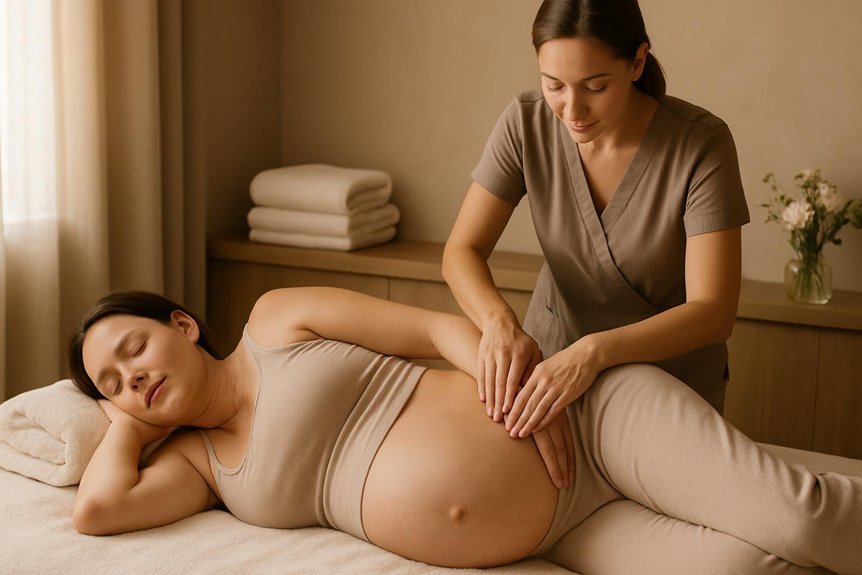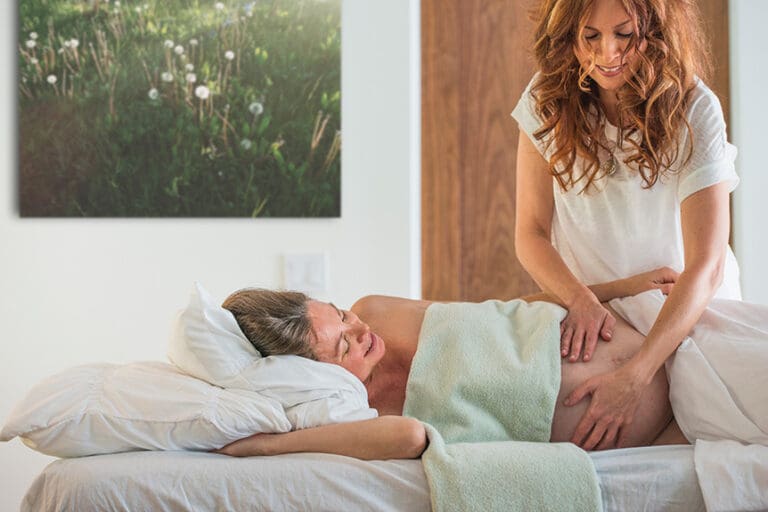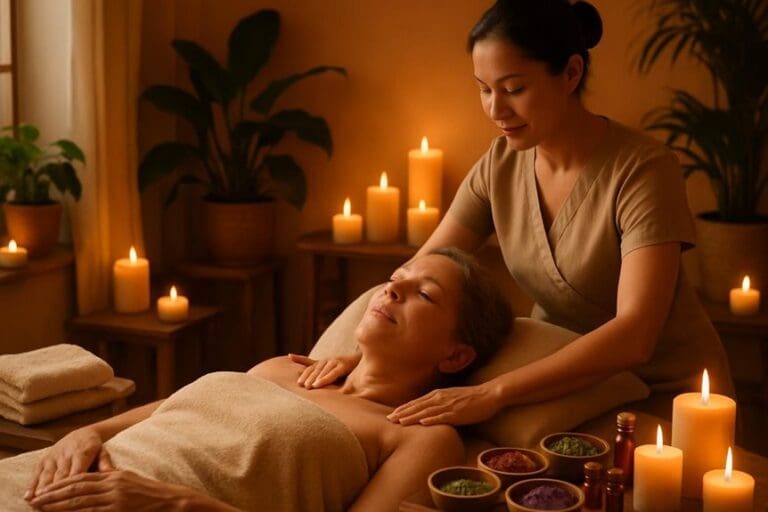Back massage in pregnancy is generally safe with gentle techniques, proper screening, and safe positioning. Side-lying or semi-reclined postures are preferred; avoid prone and deep abdominal or sacral pressure. Contraindications include preeclampsia, vaginal bleeding, fever, suspected clots, uncontrolled hypertension, significant edema, infections, or recent illness; medical clearance may be needed. Use light–moderate pressure, warmed hypoallergenic oils, and avoid points like LI4, SP6, and sacral foramina. Sessions should adapt to trimester and symptoms. Further details can help guarantee optimal safety and benefit.
Is Back Massage Safe During Pregnancy?
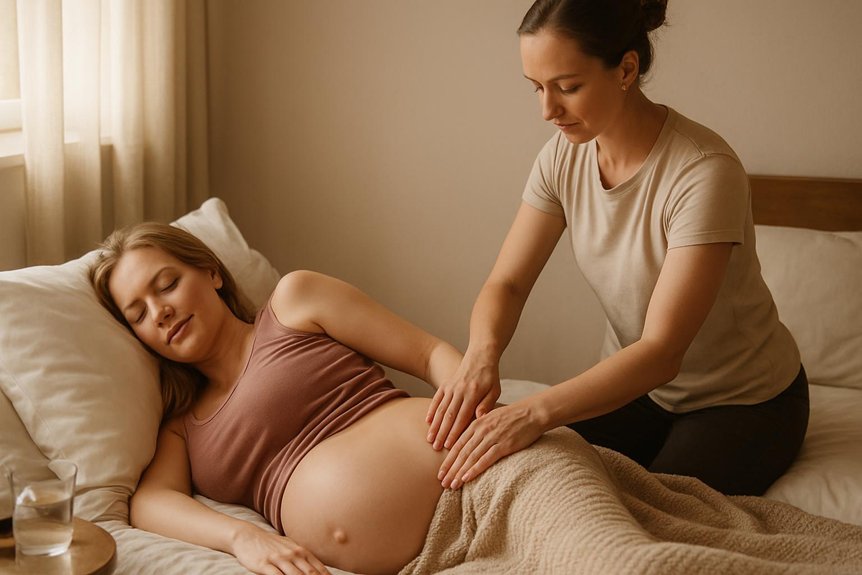
Back massage can be safe during pregnancy when adapted to gestational stage, maternal health, and evidence-based precautions. Safety depends on qualified therapists, appropriate positioning, and gentle, non-provocative techniques.
In Spa & Massage clinics across London, therapists use side-lying or semi-reclined positioning, avoid sustained pressure on the abdomen and sacrum, and keep strokes light-to-moderate, especially in the first trimester or when risks exist.
They screen for contraindications—such as preeclampsia, vaginal bleeding, severe swelling, fever, clotting disorders, or reduced fetal movements—and liaise with clients who have obstetric guidance.
Neutral, hypoallergenic oils are chosen; essential oils are limited and only used when appropriate. Heat and deep pressure are moderated.
Clients are encouraged to report dizziness, pain, contractions, or shortness of breath immediately. With these safeguards, back massage remains cautious, respectful, and nurturing. Some expectant mothers also explore the healing power of reflexology as a complementary approach to relaxation and well-being during pregnancy.
Key Benefits of Prenatal Back Massage
Prenatal back massage is associated with measurable reductions in lumbar and pelvic discomfort, improved sleep continuity, and lower perceived stress, when delivered with trimester-appropriate positioning and pressure.
At Spa & Massage, therapists use side-lying support, neutral spinal alignment, and gentle to moderate techniques to promote muscle relaxation and parasympatonic activation, which may aid mood regulation.
Safety protocols—screening for contraindications, avoiding deep work over the lumbosacral area, and adjusting sessions to maternal comfort—underpin these benefits.
Reduced Back Discomfort
Among the most reported musculoskeletal complaints in pregnancy, lumbar and sacroiliac pain respond well to targeted, safety-adapted massage. Evidence suggests gentle myofascial release, gluteal and paraspinal soft-tissue work, and sacroiliac decompression can reduce nociceptive input, ease hypertonicity, and improve pelvic alignment.
In Spa & Massage clinics, therapists position clients in side-lying with pillows to protect the vena cava, use light-to-moderate pressure within comfort, and avoid contraindicated points. Techniques are paced to breathing, inviting the body to soften without strain.
Reduced back discomfort often follows improved circulation, diminished trigger-point activity in quadratus lumborum and piriformis, and calmer sympathetic tone. Therapists provide brief home care—heat, gentle pelvic tilts, and safe stretches—to maintain relief between sessions.
Sessions remain adaptive to trimester, medical history, and daily pain patterns.
Improved Sleep Quality
How does targeted prenatal back massage influence sleep during pregnancy? Evidence suggests that gentle, side-lying back massage can reduce nocturnal awakenings by easing paraspinal muscle tension, improving thoracolumbar mobility, and supporting venous and lymphatic return.
When discomfort and restlessness diminish, sleep onset latency often shortens and total sleep time improves.
At Spa & Massage clinics in London, therapists use light-to-moderate pressure, sustained effleurage, and slow myofascial holds, avoiding contraindicated points and supine positioning after mid-pregnancy.
Safety remains central. Therapists screen for hypertension, preeclampsia risk, placenta issues, and thromboembolic history, and they coordinate with obstetric guidance.
Neutral, hypoallergenic oils are used; aromatics are optional and conservative. Clients are encouraged to hydrate, adopt left-side sleeping with pillow support, and schedule earlier sessions to respect evening wind-down.
Stress and Mood Support
Why does targeted back massage meaningfully ease stress in pregnancy? Evidence indicates it modulates the autonomic nervous system, lowering sympathetic arousal while enhancing parasympathetic tone. This shift is associated with reduced cortisol, steadier heart rate, and calmer breathing, supporting emotional steadiness.
Gentle pressure along paraspinal muscles and the sacroiliac region can also reduce nociceptive input that amplifies anxiety.
At Spa & Massage in London, therapists deliver side-lying, pillow-supported prenatal back massage using unscented or light aromatherapy oils when appropriate, monitoring comfort, pressure, and temperature. Sessions prioritise slow, rhythmic strokes to promote oxytocin release—a hormone linked to bonding and a sense of safety.
Clients are guided to pair touch with diaphragmatic breathing. Safety checks include trimester screening, contraindication review, and referral if mood symptoms suggest perinatal mental health support.
When to Avoid or Postpone a Massage
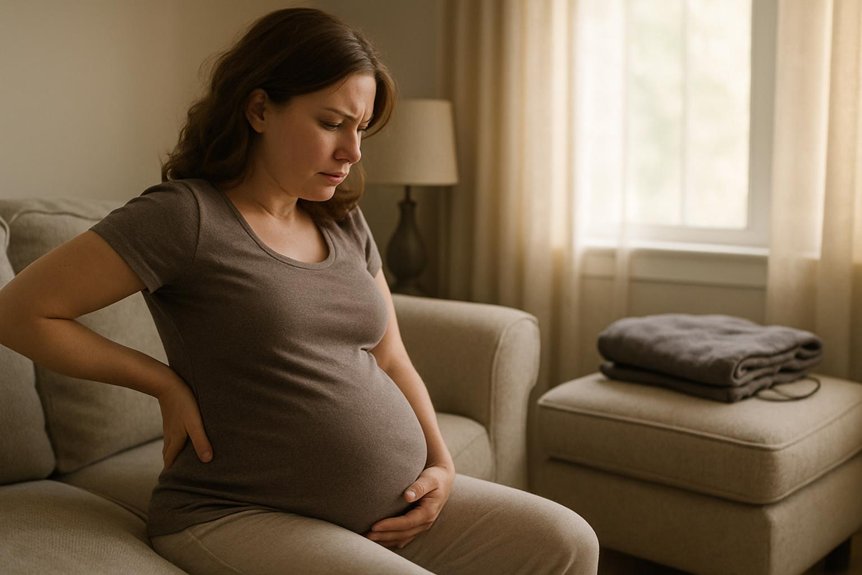
Although massage can be beneficial during pregnancy, certain situations warrant deferring treatment to protect maternal and fetal well-being. Massage should be postponed with vaginal bleeding, suspected miscarriage, preterm labour, ruptured membranes, fever, severe nausea or vomiting, uncontrolled hypertension, preeclampsia, marked edema with headache or visual change, new chest pain or shortness of breath, acute abdominal pain, or reduced fetal movements.
Avoid massage over areas with deep vein thrombosis, recent injury, rash, infection, or unhealed surgical sites.
Clients under obstetric review for placenta previa, cervical insufficiency, or growth restriction should seek written clearance.
After COVID-19 or any systemic illness, defer until fully recovered.
At Spa & Massage in London, therapists screen carefully, adapt techniques conservatively, and liaise with maternity providers when needed—prioritising safety, tenderness, and calm.
Safe Positions and Support for Comfort
Safe positioning during pregnancy minimises aortocaval compression, protects joints and ligaments, and optimises breathing. Side‑lying (left preferred) is the safest default from the second trimester, using firm pillows along the shins, between knees, and under the bump to align hips and reduce lumbar shear.
A semi‑reclined posture at 30–45 degrees supports those with heartburn or breathlessness. Prone positioning on standard tables is avoided; pregnancy cushions with adequate abdominal unloading may be used cautiously, ensuring no pelvic pressure.
Neutral neck and wrist alignment, with shoulders softly supported, reduces para‑cervical strain. Shorter holds and gentle repositioning lower dizziness risk.
At Spa & Massage, therapists stabilise with bolsters and adjustable wedges, monitor comfort and fetal‑maternal cues, and modify pressure if tingling, numbness, uterine tightening, or light‑headedness occurs.
Techniques Our Therapists Use for Expectant Mums
At Spa & Massage, therapists use side-lying positioning with bolsters to maintain spinal alignment and reduce vena cava pressure, consistent with maternity massage guidelines.
Gentle back strokes are applied to support circulation and ease paraspinal tension while avoiding excessive pressure and abdominal areas.
Targeted pressure points are addressed cautiously, with contraindicated points near the ankles, hands, and sacrum avoided.
Pressure is adjusted to the client’s trimester and medical history.
Side-Lying Positioning
Side-lying positioning is the preferred setup for pregnancy massage in Spa & Massage clinics because it reduces aortocaval compression, protects the abdomen, and supports neutral spinal alignment. Therapists arrange the client on the left or right side with the head, torso, hips, and knees aligned.
A firm pillow or wedge supports the bump; additional bolsters stabilise the pelvis and cushion the knees and ankles to minimise sacroiliac strain.
This arrangement allows precise access to the back and hips while keeping maternal blood flow and fetal perfusion ideal. Therapists monitor comfort, breath pattern, and temperature, adjusting angles to avoid numbness or reflux. Pressure is kept within tolerance, with clear consent at each step.
In our London clinics, sessions are adapted trimester-by-trimester, prioritising circulation, joint safety, and calm, reassuring touch.
Gentle Back Strokes
Gentle back strokes are applied in a side-lying setup to modulate sympathetic activity, ease paraspinal tension, and support venous return without provoking uterine irritability. At Spa & Massage, therapists use slow, longitudinal effleurage from sacrum to mid-thoracic levels, following lymphatic and venous pathways.
Pressure remains light-to-moderate, avoiding spinous processes and maintaining continuous contact for reassurance and thermal comfort.
Hypoallergenic, unscented or mild aromatherapy oils are selected after screening for sensitivities; strokes are warmed before application to reduce startle responses. Rhythm is paced to breathing, encouraging vagal tone and lowering perceived pain.
Strokes always move toward the heart, with hands broad and relaxed to disperse load uniformly. Therapists reassess blood pressure, positioning, and client feedback throughout, adapting cadence and depth to trimester-specific needs.
Targeted Pressure Points
Targeted pressure point work in pregnancy focuses on safe, evidence-informed acupressure and myofascial trigger point modulation to relieve common discomforts while avoiding zones linked to uterine stimulation.
At Spa & Massage, therapists apply light-to-moderate, sustained pressure to paraspinal points, gluteal trigger points, and the upper trapezius to ease low-back ache, sciatica-like tension, and shoulder strain. They deliberately avoid contraindicated areas such as LI4, SP6, and sacral foramen points.
Assessment guides placement: clients lie in a supported side-lying position with cushions to protect hips and bump. Pressure is increased gradually, held for 20–60 seconds, and released slowly to prevent rebound tenderness. Unscented, hypoallergenic oils are used to reduce friction.
Aftercare includes gentle heat, hydration, and brief walking. Sessions remain responsive—if tenderness sharpens, pressure softens immediately.
What to Expect at a Prenatal Massage Appointment
Although every session is tailored to gestational stage and health status, a prenatal massage at Spa & Massage follows a structured, safety-led process.
On arrival, a therapist conducts a brief clinical screen covering trimester, pregnancy complications, medications, pain patterns, and recent changes. Consent, preferences, and pressure tolerance are clarified.
Positioning prioritises uterine and venous safety: side-lying with pillows or a semi-reclined setup; prolonged supine or prone positioning is avoided.
In our clinics, neutral, hypoallergenic oils are used; aromatics are introduced only if appropriate.
Techniques emphasise gentle myofascial work, rhythmic effleurage, and light-to-moderate pressure to the back, hips, and shoulders, avoiding contraindicated points and deep abdominal work.
Throughout, communication is quiet and attentive.
Sessions end with personalised guidance on comfort, hydration, and recognising red-flag symptoms.
At-Home Self-Care Tips Between Sessions
Between prenatal massage appointments, consistent self-care helps manage musculoskeletal strain, swelling, and sleep disruption common in pregnancy.
Spa & Massage recommends brief, frequent strategies over forceful techniques. Side-lying rest with a pillow between knees and a small roll at the waist reduces lumbar load; a warm (not hot) shower or compress eases stiffness.
Gentle pelvic tilts, cat–cow, and ankle pumps—10 slow repetitions—support circulation and mobility.
For self-application, light stroking along the paraspinals and gluteals with unscented or mild aromatherapy oil is appropriate; in our clinics, therapists advise avoiding deep pressure on the low back and sacrum.
Elevating legs for 15 minutes reduces edema.
Hydration and magnesium-rich foods may lessen cramps.
Seek urgent care for sudden swelling, headache, visual changes, or calf pain.
Conclusion
In closing, the journey reads like a well-charted voyage: the expectant body is a vessel, the back its weathered hull, and massage a calibrated compass. When navigated by evidence—clear contraindications, trimester‑appropriate positioning, and gentle, monitored pressure—the waters calm, circulation steadies, and sleep finds harbor. Yet reefs remain: red‑flag symptoms demand medical pilots, not improvisation. With informed consent and qualified hands, each session becomes a safe crossing—supportive, precise, and focused on mother and baby arriving securely ashore.
